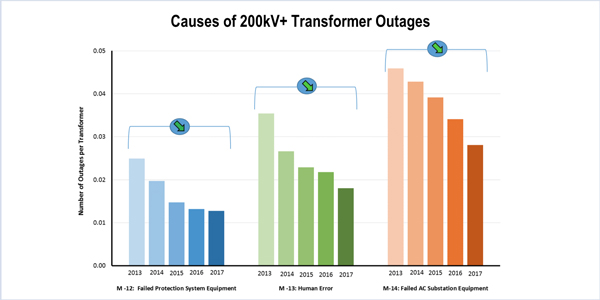By Rich Heidorn Jr.
The bulk power system showed improved ability to rebound from severe storms last year while continuing to improve on most other reliability metrics, NERC said last week.
NERC cited two Category 5 events — the most severe — last year in hurricanes Harvey and Irma. “While wind and water damage were record setting, the restoration efforts and subsequent recovery times were improved from historical benchmarks,” NERC reported in its State of Reliability 2018 report.
Harvey damaged 85 substations and more than 850 transmission line structures in South Texas, resulting in 225 transmission line outages. But utilities’ use of amphibious vehicles, airboats and aerial drones allowed them to perform damage assessments even before roads were clear of flooding and storm debris, NERC noted.
Irma caused a record number of electric outages in Florida, with 4.45 million customers losing power in Florida Power & Light’s territory, up from 3.24 million from Hurricane Wilma in 2005. But system hardening between the two storms reduced restoration time to 10 days from 18, NERC said.
The report recommended NERC encourage increased use of mutual assistance programs and drones and increase information sharing by publishing event reports and conducting other outreach on the lessons learned from the storms.
The storm observations were among six findings in the NERC report. The organization also found that:
- Inverter disconnects during transmission disturbances are becoming an emerging risk. It cited phase-to-phase faults on 220-kV and 500-kV lines during the Canyon 2 Fire east of Los Angeles last October, which resulted in the loss of more than 900 MW of solar PV in Southern California Edison’s territory. It also noted a 500-kV line fault during the 2016 Blue Cut Fire in San Luis Obispo County, Calif., that led to the loss of 1,000 MW of BPS-connected solar PV. “The majority of these inverter-based resources tripped offline due to sub-cycle transient overvoltages and instantaneous protective action at the inverters to disconnect them from the grid,” NERC said. (See Solar Inverter Problem Leads CAISO to Boost Reserves.)
Bulk power system transmission events resulting in loss of load. Load loss was lower in 2017 than in any year since 2002. (Note: Chart excludes Criteria 4, added in 2013.) | NERC - There was no loss of load because of cyber or physical security events, but “grid security, particularly cybersecurity, is an area where NERC and the industry must continually improve defenses as threats continue to rapidly evolve.” It said the industry should continue to push for security improvements through “technological hardening, growing a culture of security, and effective information exchange between entities, the E-ISAC [Electricity Information Sharing and Analysis Center] and trusted partner organizations.” It urged continuing to improve critical infrastructure protection standards and giving “particular attention” to supply chain risks. It called for expanding participation in the E-ISAC by lowering the cost of participation and seeking Department of Energy funding.
- Transmission outages resulting from failed protection system equipment, AC substation equipment (e.g., breakers, transformers) and human error — historically among the largest causes of transmission outages — all decreased over the last five years. “However, these areas remain major contributors to transmission outage severity and will remain areas of focus,” NERC said.
Annual frequencies of automatic outages of 200-kV+ transformers for 2013–2017. Green arrows indicate overall improvement. | NERC - Frequency response performance remained acceptable but varied among the four interconnections. The Eastern, Texas and Quebec Interconnections “trended ‘improving’ during the arresting period,” while the Western and Texas Interconnections “experienced statistically significant improvement during the stabilizing period” for 2013-2017. No interconnection fell below its interconnection frequency response obligation (IFRO).
- Protection systems misoperations rates declined for the fifth consecutive year but remain high priorities. The overall NERC misoperation rate fell to 7.1% in 2017 from 8.3% in 2016, while the three largest causes of misoperations remained the same year-over-year: incorrect settings/logic/design errors, relay failure/malfunctions and communication failures. “Protection system misoperations exacerbate the impact of transmission outages, thereby increasing their severity,” NERC said.
The report said the only metric “indicating cause for concern” is planning reserve margins, with all regions except for the Texas Regional Entity projecting sufficient reserves for the next five years.
It cited ERCOT’s preliminary summer seasonal assessment of resource adequacy (SARA), which reported that operational tools such as load management and distribution voltage reductions could be needed to maintain sufficient operating reserves.
In its final SARA for summer, ERCOT reported that its anticipated resources had increased by 581 MW, NERC noted. (See ERCOT Sees Enough Generation Through 2022, 73-GW Peak for Summer.)






